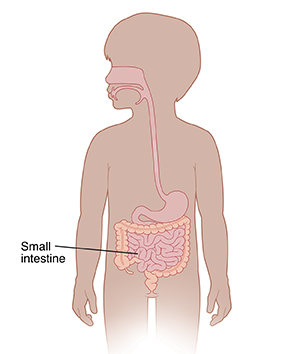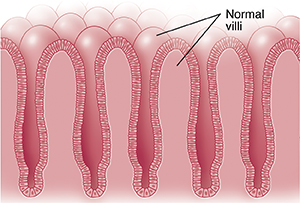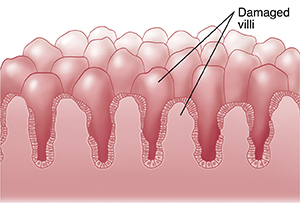When Your Child Has Celiac Disease
Celiac disease is a chronic (lifelong) digestive problem that affects your child’s ability to get nutrients from food. It's caused by an immune-based reaction to gluten in food. Gluten is a protein found in many grains including wheat, rye, and barley. Celiac disease affects tiny finger-like stalks (villi) in the small intestine. The villi collect nutrients from the food your child eats. But celiac disease damages the villi. Damaged villi can’t absorb enough nutrients, even if your child is eating plenty of food. There is no cure for celiac disease. But it can be managed and the damage reversed.

 |
| Villi are tiny fingerlike stalks that line the small intestine. They absorb nutrients from digested food. |
 |
| When your child has celiac disease, the villi become damaged and cannot absorb nutrients properly. |
What are the symptoms of celiac disease?
Some children with celiac disease don’t feel symptoms. But many children with celiac disease feel sick, often after eating. Common symptoms in children include:
-
Belly pain
-
Bloating
-
Constipation
-
Greasy, foul-smelling diarrhea
-
Irritable or grumpy mood
-
Loss of muscle mass (muscle-wasting)
-
Not growing well
-
Vomiting
-
Iron deficiency anemia (older children)
-
Bone problems (older children)
What causes celiac disease?
The cause of celiac disease is not known. It's often passed down in families. It may affect more than one family member. Children may be exposed to gluten for the first time when they start eating solid foods. This mostly happens between 4 and 6 months of age. But they may not develop the disease right away. It could be years before they start having symptoms.
How is celiac disease diagnosed?
Tests can be done to find out if your child has celiac disease. These tests may include:
-
Blood and stool tests. These tests can help to rule out other digestive problems.
-
Blood test specific for celiac disease. For the test to be accurate, your child needs to continue eating foods with gluten. The healthcare provider can tell you more.
-
Endoscopy with biopsy. An endoscope is a long, thin tube with a camera on the end. Your child will be sedated during the procedure. It's inserted through the mouth and stomach into the duodenum (the first part of the small intestine). This lets the healthcare provider see inside your child’s intestine. During a biopsy, a tiny sample of tissue is taken from the duodenum. This tissue sample is looked at under a microscope to check the tiny villi for damage. This test must be done during the time your child is still eating food with gluten. This is the only way to see if the presence of gluten is damaging the villi.
How is celiac disease treated?
To treat celiac disease, your child will need to be put on a gluten-free diet. This will let the villi heal and start to absorb nutrients again. Gluten must be removed even if your child feels fine and doesn’t have symptoms. If it isn’t, celiac disease can lead to serious health problems. Your child must stay on a gluten-free diet for the rest of their life. If your child has low vitamin levels, your provider will advise supplements. From time to time, your child may need to have blood tests or an endoscopy with biopsy repeated. This is to check on symptoms or the status of the celiac disease.
Long-term concerns
Over time, children with celiac disease who don’t stop eating gluten can develop health problems. These problems can include a lack of needed vitamins and minerals (malnutrition), bone weakness, and shorter height. If celiac disease isn’t treated, there is an increased risk of intestinal cancer later in life. So it’s important to remove all gluten from your child’s diet. Work with your child’s healthcare provider to learn about sources of gluten in food and other products. Even when treated, the condition may be associated with other diseases, such as diabetes or thyroid conditions. Talk with your child's healthcare provider about other signs or symptoms of illness you should watch for. It's helpful to see a dietitian to make a plan for a gluten-free diet.
Grains containing gluten
-
Wheat
-
Barley
-
Bulgur
-
Kamut
-
Malt
-
Rye
-
Semolina
-
Spelt
Note: Oats don’t contain gluten, but your child may need to pass them up anyway, because some oats are contaminated with gluten. Talk with your child’s healthcare provider.